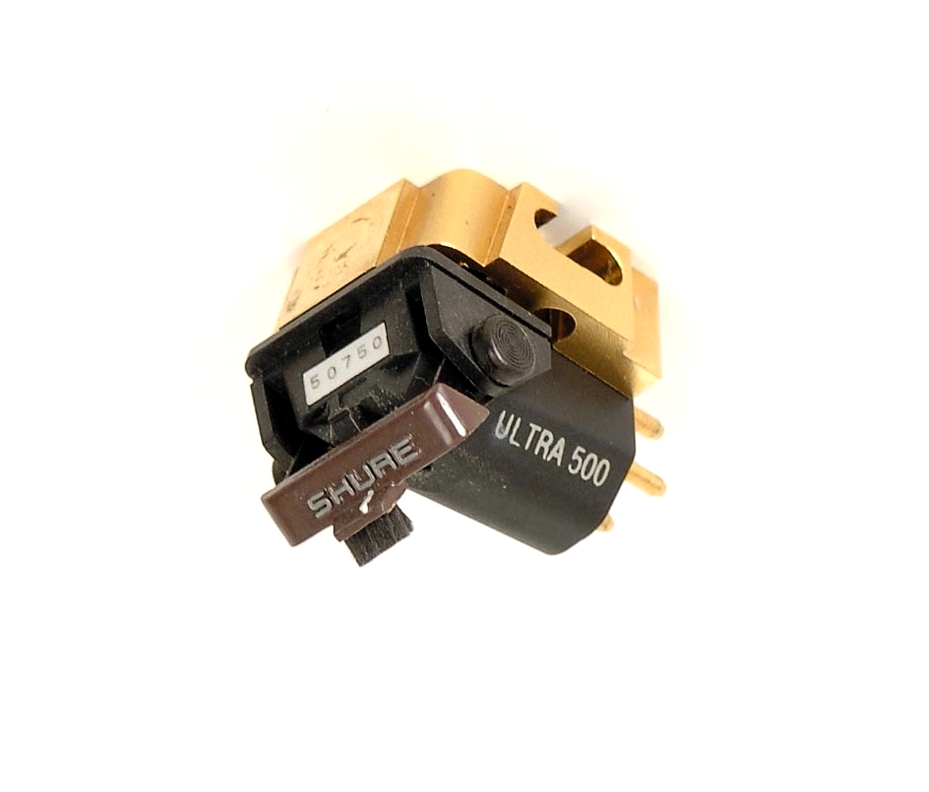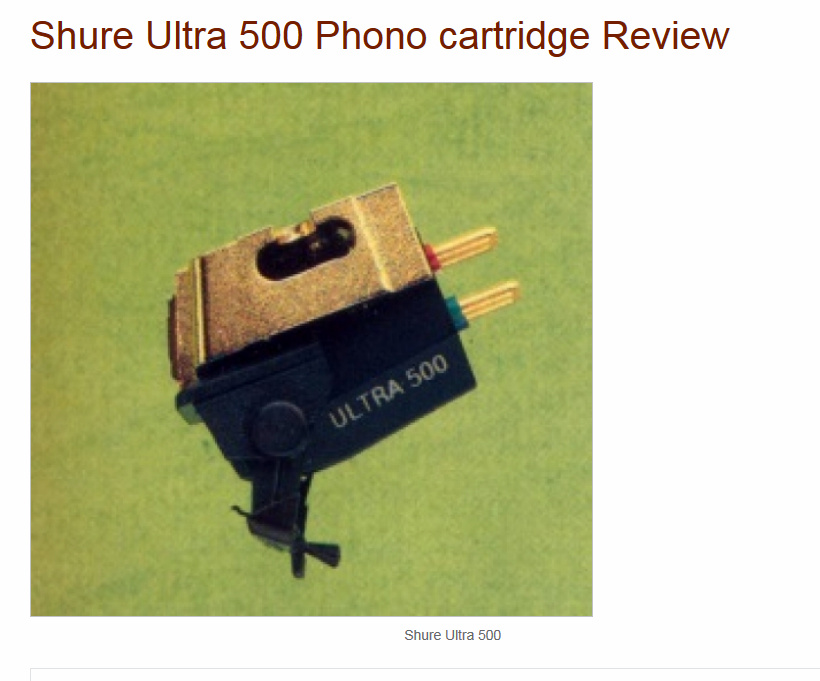Shure ULTRA-500
Data[edit]
General
- Manufacturer: Shure
- Model: ULTRA-500
- Type: Pickup
- Years of manufacture: 1986 - 1989
- Original price approx.: 1'450 DM
Technical data from test report in "Fono-Forum 7/86
Remarks[edit]
- Other models in the same series:
- Standard M-series pickups:
- Shure M-44-7
- Shure M-44 C
- Shure M-44 E
- Shure M-44 G
- Shure M-55 E
- Shure M-92 E
- Shure M-99 E
- Shure M-104 E
- Shure M-105 E
- Shure M-110 HE
- Shure M-111 HE
- Top-of-the-line ML-series pickups:
- Shure ML-120 HE
- Shure ML-140 HE
- Top-of-the-line ULTRA series pickups:
- Shure ULTRA-300
- Shure ULTRA-400
- Shure ULTRA-500
- Studio and discotheque pickups:
- Shure DC-40
- Shure DC-50
- Shure DC-60
- Shure SC-35 C
- Shure SC-39 B
- Shure SC-39 EJ
Pictures[edit]
- Image: Shure ULTRA-500
- Image: Shure ULTRA-500
Reports[edit]
- Test report in "Fono-Forum 7/86".
- Test report in "Hifi-Analog 13/2017"
- Test report in "Hifi-Classic":
- Shure Brothers' Ultra phono cartridges are aimed at the high-end audiophile. Although they have much in common with the widely acclaimed leader of Shure's regular line, the V15 Type V-MR, the Ultra cartridges are said to be individually assembled with tighter tolerances and fine-tuned for peak performance. There are currently three Ultra models, the 300, the 400, and the 500, and we tested the top-of-the-line Ultra 500.
Functionally, the Ultra 500 is almost identical to the V15 Type V-MR, sharing with it a Micro-Ridge line-contact stylus, a thin-wall beryllium-stylus cantilever, and a pivoted Dynamic Stabilizer that serves multiple roles as a pickup damping device, record brush, destaticizer, and stylus guard. The Ultra 500's replacement stylus appears to be identical to the stylus of the V15 Type V-MR (we verified that they are interchangeable), and the encapsulated cartridge bodies of the two models also appear to be identical. In addition, they have the same specifications for coil inductance and resistance, output voltage, and optimum load requirements. Comparing the manufacturer's specifications for the two cartridges, we could find only three significant differences: the Ultra 500 has gold-plated pins and a substantially higher "trackability" rating at all frequencies; it is rated to track at a slightly higher force, 1.2 grams rather than 1.0 grams; and it is heavier, 9.3 grams rather than 6.6 grams.
The greater weight of the Ultra 500 is due to the metal mounting block that couples the encapsulated cartridge body to the tonearm. It is widely held in high-end audio circles that a cartridge must have extremely tight mechanical coupling to its headshell to avoid resonances that can color the sound. The Ultra 500's mounting block provides the maximum surface contact area between cartridge and headshell, and it has integral mounting nuts to simplify installation. To further enhance the mechanical unity of the pickup system, the Ultra 500 mounts with Allen-head screws, which can provide a greater bonding force than the usual slotted-head screws. An Allen wrench is provided with the cartridge instead of the customary screwdriver.
The Shure Ultra 500 is packaged in an attractive walnut-finish wooden jewel box together with the mounting hardware, Allen wrench, dummy alignment stylus, stylus-cleaning brush, and a vial of stylus-cleaning fluid. Price: $400.
Lab Tests:
The extra weight of the Ultra 500 caused us some problems in mounting it. Most good modern tonearms are designed to balance a cartridge weighing from 4 to 8 grams, and almost all modern cartridges fall between those limits. With the first two turntables we tried, the arms were unable to balance the 9.3-gram Ultra 500. The third, an older but high-quality player with a moderately massive tonearm, was able to accommodate it. We operated the Ultra 500 at its rated tracking force of 1.2 grams, with the arm set to 1.7 grams to compensate for the effect of the 0.5-gram Dynamic Stabilizer brush.
The optimum load for the Ultra 500 is stated to be 47,000 ohms in parallel with 250 picofarads. We measured its frequency response with capacitive loads of 140, 275, and 550 pF. The 275-pF load gave the flattest response, ±0.5 dB from 40 to 20,000 Hz, although the 140-pF response varied by the same amount and differed from the optimum curve by no more than 0.5 dB over the full frequency range. The highest capacitance produced a response rise of 1 dB at 10,000 Hz and a drop of 2.5 dB at 20,000 Hz.
The square-wave response of the cartridge with the CBS STR 112 test record was excellent. There was a slight ringing at about 35,000 Hz (possibly the stylus resonance frequency, although this test record also has some ringing in the same frequency range) and a rise time of 15 microseconds, which corresponds to an upper response limit of 23,000 Hz. This figure, however, includes the response of the record as well as that of the cartridge.
The channel separation of the Ultra 500 was about 30 dB up to 5,000 Hz, decreasing to 25 dB at 10,000 Hz and 13 dB at 20,000 Hz. The output from a 1,000-Hz test band recorded at 3.54 cm/s was 2.85 mV, with a channel imbalance of less than 0.2 dB. The vertical stylus angle was 20 degrees. In view of the considerable mass of both the arm and cartridge-their total effective mass was 33 grams-and the high stylus compliance of the Ultra 500, the system resonated at about 6 to 7 Hz. Fortunately, the Dynamic Stabilizer was quite effective in damping this resonance, so that the system was able to track warped records moderately well.
The Ultra 500 tracked our Cook and Fairchild high-velocity test records easily, as well as the 90-micro-meter level of the German HiFi #2 record. At the 100-micrometer level, however, it showed traces of mistracking. It is possible that a slight warp on the record, combined with the high arm/cartridge mass, caused the mistracking. When we used the newer DIN 45549 test record, which may have been flatter than the older HiFi #2 record, the Ultra 500 tracked its 100-micrometer level.
Our tracking-distortion measurements were made with the Shure TTR-103 test record. The difference-frequency intermodulation distortion (playing equal-amplitude tones of 1,000 and 1,500 Hz) was 0.3 percent at 15 cm/s and 0.8 percent at 30 cm/s. The 10.8-kHz tone-burst distortion was nearly constant and very low, 0.35 to 0.42 percent over the same range of recorded velocities.
Comments:
Unquestionably, the Shure Ultra 500 is a superb cartridge. Its frequency-response and channel-sepa-ration characteristics are as nearly perfect as anything we have measured. The benefits of the Shure Dynamic Stabilizer have been recognized for years. It is one of the most effective damping devices we have seen, and it goes a long way toward eliminating the undersirable effects of arm/cartridge resonances.
The cartridge sounded every bit as good as it measured. We believe it does as faithful a job of extracting the information from a record groove as has been achieved by any phono cartridge. However-and this is a big "however"-the same comments apply to the Shure V15 Type V-MR, which is roughly half the price of the Ultra 500. We have never found a music record that the V15 Type V-MR could not track with ease, yet the Ultra 500 has a substantially higher rated "track-ability. The Allen-head mounting screws and unique mounting block of the Ultra 500 are excellent features, though we wish they added less mass. We noted with regret that the superb cartridge-alignment and mounting fixture that Shure provides with the V15 Type V-MR was absent from the Ultra 500's jewel-box case.
The Shure Ultra 500 may have appeal to a limited but highly selective part of the market consisting of high-end audiophiles. If you can hear something in the sound from the Ultra 500 that justifies spending $400, and if your turntable's tonearm can balance its mass, then your choice is clear.

